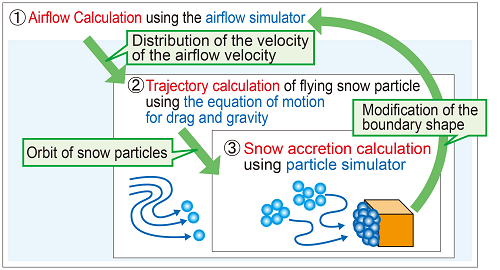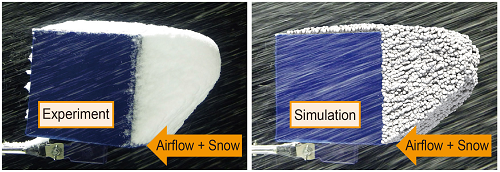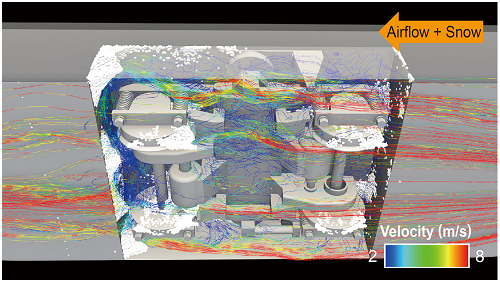27. Snow accretion simulation method for high speed trains
Snow thrown up from passing trains accumulates and gradually collects on train bodies and bogies.
When this accumulated snow falls off a running train, it can cause flying ballast, which in turn can cause damage to signaling equipment or train bodies.
As a means to explore and develop measures to prevent snow accretion therefore, a snow accretion simulation method has been developed which can reproduce the snow accretion process.
The newly developed simulation method combines an airflow simulator with a particle simulator (Fig. 1).
The simulation process follows a series of steps:
① The distribution of the velocity of the airflow are calculated around the target object using the airflow simulator.
② The trajectories of the flying snow particles are calculated using the velocity of the airflow.
③ Snow accretion is calculated around the target object using the particle simulator.
Given that the target object shape will change as snow accumulates, the shape is updated, and the calculations in steps 1-3 above are repeated to obtain the snow accretion shape on the object.
The capacity of the snow accretion simulation method to reproduce a shape similar to that formed during snow accretion experiments was validated using snowfall wind-tunnel experiments (Fig. 2).
Figure 3 shows the results of the snow accretion simulation on a train model. The white dots show the collected snow, while the color of stream lines indicates the magnitude of air flow velocity.
This snow accretion simulation method makes it possible to obtain insight into the relationship between airflow and snow accretion, and if applied to the actual train shapes, can be used to find train shapes that reduce snow accretion.
Other Contents
- 26. Head car collision testing and numerical simulation
- 27. Snow accretion simulation method for high speed trains
- 28. Ground-to-train communication system using 90 GHz band millimeter-wave
- 29. Mechanisms underlying slope collapse due to rain or during an earthquake resulting from changes in water content of volcanic soil
- 30. Factors influencing concrete deterioration due to expansion
- 26. Head car collision testing and numerical simulation
- 27. Snow accretion simulation method for high speed trains
- 28. Ground-to-train communication system using 90 GHz band millimeter-wave
- 29. Mechanisms underlying slope collapse due to rain or during an earthquake resulting from changes in water content of volcanic soil
- 30. Factors influencing concrete deterioration due to expansion



